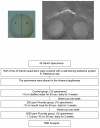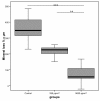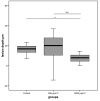Effect of a 5000 ppm fluoride toothpaste and a 250 ppm fluoride mouth rinse on the demineralisation of dentin surfaces
- PMID: 19627581
- PMCID: PMC2723123
- DOI: 10.1186/1756-0500-2-147
Effect of a 5000 ppm fluoride toothpaste and a 250 ppm fluoride mouth rinse on the demineralisation of dentin surfaces
Abstract
Background: The purpose of this study was to test the null hypothesis that there is no difference between the effect of (1) a 5000 ppm fluoride toothpaste, and (2) a 250 ppm fluoride mouth rinse on demineralized human dentin surfaces, against the alternative hypothesis of a difference.
Findings: Dentin specimens were obtained from the cervical regions of 45 extracted human third molars. Half the surface of each specimen was sealed with a self-etching adhesive system and served as the reference surface. The dentin specimens were randomly assigned to one of the three groups, 5000 ppm fluoride toothpaste (Duraphat), 250 ppm fluoride mouth rinse (Meridol) and distilled water (negative control).An intraoral appliance was made for one volunteer. In each test cycle, 15 specimens were inserted in the appliance and worn for 24 hours a day, over a period of three weeks.Once daily, the appliance was immersed in the agent being tested; either toothpaste slurry, mouth rinse or distilled water for 60 seconds.Demineralization was assessed in terms of lesion depth (microm) and mineral loss (vol. % x microm) by transversal microradiography. Data analysis was accomplished using Kolmogorov-Smirnov test and ANOVA (SPSS 12.0).Statistically significant differences for mineral loss and lesion depth were found between the toothpaste and the mouth rinse as well as between the toothpaste and the control group, but not between the mouth rinse and the control group.
Conclusion: Within the limitations of this study, the results suggest that treatment of demineralised dentin with a toothpaste containing 5000 ppm fluoride may considerably reduce mineral loss and lesion depth on exposed dentin.
Figures



Similar articles
-
Effect of high-fluoride toothpaste and mouth rinse on the prevention of demineralized lesions during orthodontic treatment: a randomized controlled trial.Eur J Orthod. 2023 Sep 18;45(5):477-484. doi: 10.1093/ejo/cjad044. Eur J Orthod. 2023. PMID: 37524332 Free PMC article. Clinical Trial.
-
Efficacy of fluoride toothpaste in preventing demineralization of smooth dentin surfaces and narrow grooves in situ under frequent exposures to sucrose or bananas.Caries Res. 2005 Mar-Apr;39(2):116-22. doi: 10.1159/000083156. Caries Res. 2005. PMID: 15741723 Clinical Trial.
-
NaF rinse and dentifrice concentrations on enamel lesion demineralization.Am J Dent. 2016 Oct;29(5):243-247. Am J Dent. 2016. PMID: 29178734
-
The Effect of Actives in Desensitizing and Conventional Mouth Rinses Against Dentin Erosive Wear.Braz Dent J. 2024 Oct 28;35:e245500. doi: 10.1590/0103-6440202405500. eCollection 2024. Braz Dent J. 2024. PMID: 39476045 Free PMC article.
-
Fluorides for preventing early tooth decay (demineralised lesions) during fixed brace treatment.Cochrane Database Syst Rev. 2019 Nov 17;2019(11):CD003809. doi: 10.1002/14651858.CD003809.pub4. Cochrane Database Syst Rev. 2019. PMID: 31742669 Free PMC article.
Cited by
-
High-fluoride toothpaste: a multicenter randomized controlled trial in adults.Community Dent Oral Epidemiol. 2014 Aug;42(4):333-40. doi: 10.1111/cdoe.12090. Epub 2013 Dec 20. Community Dent Oral Epidemiol. 2014. PMID: 24354454 Free PMC article. Clinical Trial.
-
Effect of 10% fluoride on the remineralization of dentin in situ.J Appl Oral Sci. 2015 Nov-Dec;23(6):562-70. doi: 10.1590/1678-775720150239. J Appl Oral Sci. 2015. PMID: 26814458 Free PMC article. Clinical Trial.
References
LinkOut - more resources
Full Text Sources

